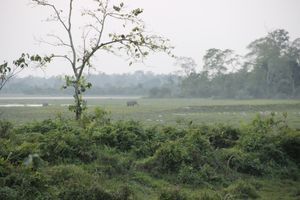Notes from Kaziranga: The microcosmos of an elephant’s gut
 Dec 26, 2015 • 5:51 AM UTC
Dec 26, 2015 • 5:51 AM UTC Unknown Location
Unknown Location 140x Magnification
140x Magnification Microorganisms
Microorganisms
laksiyer
Human observer of life. https://sukshmadarshin.wordpress.com
97posts
1255comments
5locations


The large mammals of Kaziranga are a sight to behold: the giant elephant, the fortress-like one-horned rhino and the wild buffalo. Although we were in Kaziranga sampling the microcosmos, these giants stood out in the vast forest background, and it was difficult not to admire their majestic presence. In one of our workshops, there was a small sample of elephant dung.
The dung has a characteristic odor and a very grassy feel, mainly because the elephant’s diet is largely composed of vegetation. Elephants have a digestive system much like ours and the breakdown of cellulose is facilitated by a vast microflora in the caecum, at the junction of the small and large intestines. The dung is filled with cellulose fibers and the little particles that you see in the movie are likely to be gut microorganisms (my best guess). Towards the end of the movie however, you see this striking oval object that got me tremendously excited. We agreed among the foldscope team members that it is likely to be a parasitic worm egg, although it would have been great to see it in multiple numbers. I showed the video to Professor Barua and another young professor of the Assam Agriculture university, both expert veterinarians, and it took them all of one second to say that this was a nematode egg.

The identification only left me with more questions, which can possibly be answered only by the residents and full-time researchers of one of the most beautiful and biodiverse parks of India: What nematode was this? What was its lifecycle? Did it have multiple hosts? Does it infect humans? Is it found in the domestic animals around the national park? How big is the worm? Does it show seasonal variations in populations? Could we get to the bottom of this?
P.S. I have heard of an interesting elephant dung observation and many others have reported something similar. Once an elephant excreted its dung on the road, and immediately as it moved, stray dogs rolled in it? Is there a biological basis for this behavior?
P.S. I have heard of an interesting elephant dung observation and many others have reported something similar. Once an elephant excreted its dung on the road, and immediately as it moved, stray dogs rolled in it? Is there a biological basis for this behavior?
Sign in to commentNobody has commented yet... Share your thoughts with the author and start the discussion!

 0 Applause
0 Applause 0 Comments
0 Comments_300x300.jpeg)

















